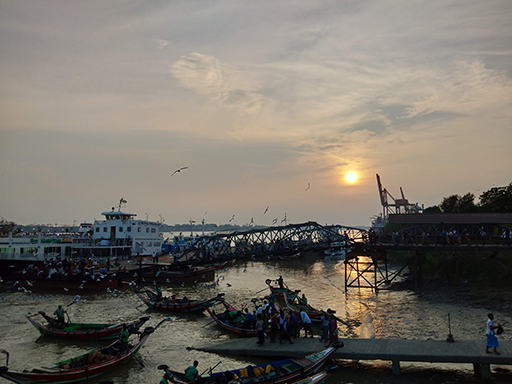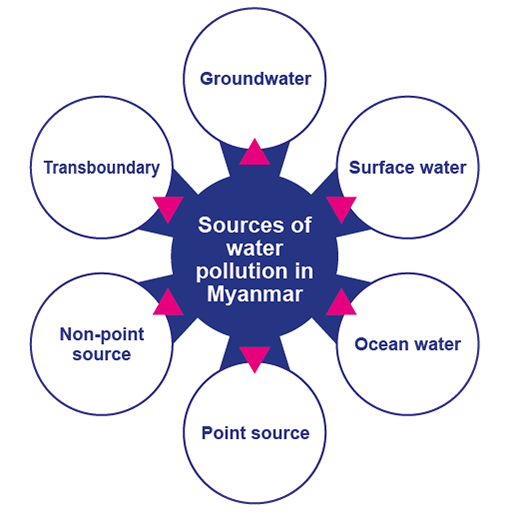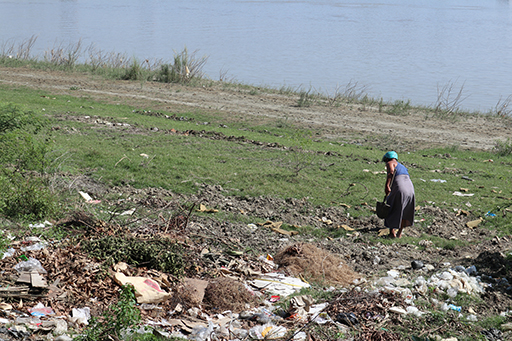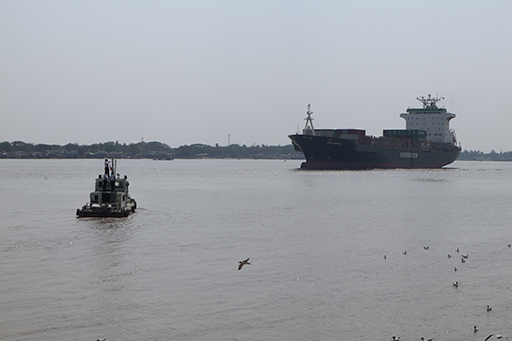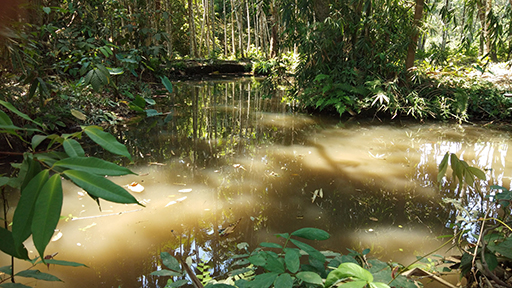Use 'Print preview' to check the number of pages and printer settings.
Print functionality varies between browsers.
Printable page generated Friday, 26 April 2024, 6:50 AM
Chapter 3 Causes and effects of water pollution
3.1 Introduction
Water pollution negatively affects the quality of water. It occurs when harmful substances – often chemicals or microorganisms – contaminate a stream, river, lake, ocean, aquifer, or other body of water, degrading water quality and rendering it toxic to living organisms. Water pollution is one of the major global problems today and has been linked to 1.8 million deaths globally each year (Time, 2017).
This chapter explores water pollution in Myanmar, its sources, causes and effects. Unlike vast areas of the planet where water is scarce and people face shortages, Myanmar is a country with abundant water resources but where the quality of water is poor. This has adverse consequences for the health of the Myanmar population and the country’s ecosystems.
3.2 What is water pollution?
Water pollution is any change in the physical, chemical or biological properties of water that will have a detrimental consequence on any living organism. Contamination of water bodies happens both naturally and by human activity.
Water pollution happens naturally when naturally occurring chemicals, dissolved in water, change in concentration (such as sodium, chloride or sulphate). This is called the sediment cycle, which starts with the process of erosion, whereby particles or fragments are weathered from rock material followed by the erosion of minerals, their transport and deposition, then burial. Action by water, wind, glaciers, and plant and animal activities all contribute to the erosion of the earth's surface. Fluvial sediment is the term used to describe the case where water is the key agent for erosion.
Changes in geology, the closeness to the sea, and the progress of water downstream from headwaters can all give rise to natural forms of chemical pollution. For example, Myanmar’s groundwater near the coast is saline, and inland it is contaminated by naturally occurring arsenic that harms living organisms.
Sediment plays a major role in the transport and fate of pollutants. Toxic chemicals can become attached or absorbed by sediment particles and then transported and deposited in other areas. These pollutants may later be released into the environment. Furthermore, contaminants accumulate over long periods of time in the sediments. Some toxic substances that may reside in the sediment (e.g. mercury) can re-enter the water system when the sediments are dredged.
But as well as natural forms of water pollution, human activity adds contaminants to water courses that more substantially disrupt normal environmental processes as the following two case studies demonstrate.
Mandalay Industrial Zone (MIZ)
The MIZ area includes facilities that cause severe pollution such as tanneries, distilleries, sugar factories and battery factories.
Since 2008, if not earlier, untreated wastewater has been released from the MIZ into a canal that supplies water for the Nat Yay Kan fishery ponds and feeds into Taungthaman Lake. This pollution has caused a series of large die-offs in the fish populations in Taungthaman Lake.
In 2013, Myanmar’s Ministry of Industry supplied a list of 63 factories that were dumping wastewater into surrounding waterways, though the total number may be far higher. Several factories have been fined but none has agreed to stop dumping pollutants, despite the fact that the Mandalay City Development Committee is legally obligated to ensure that they do so.
Though required to do so by law, none of the factories in MIZ have publicised an Environmental Management Plan or an Environmental Compliance Certificate.
(Source: Earth Rights International (2019) Pollution in Myanmar.)
Question 1
Fines have not worked in stopping companies releasing untreated industrial wastewater into the canal that supplies the Nat Yay Kan fishery ponds. The Mandalay City Development Committee has responsibility to stop the contamination.
Imagine you are a member of the Committee faced with the following options to improve factory compliance with the law.
In which order would you use each option?
Tip: perhaps start softly (number 1), moving towards harder options (number 5) if the companies still do not comply.
Using the following two lists, match each numbered item with the correct letter.
Visit the factories and explain the law
Mediate a solution between the factories and Nat Yay Kan fishery ponds
Highlight the problem through the media
Raise fines to make them more of a deterrent
Prosecute the companies
a.1 (soft option)
b.4
c.5 (hard option)
d.3
e.2
- 1 = a
- 2 = e
- 3 = d
- 4 = b
- 5 = c
Answer
This is a model answer, there is no right or wrong answer. However, this model answer represents one strategy that emphasizes dialogue and building understanding among the different stakeholders (a person, group or organization with an interest or concern in something), and only as a last resort moves to more punitive measures.
3.3 Sources of pollution in Myanmar
There is very little treatment of water in Myanmar, which is why 80% of fresh water flowing on the surface of the land is contaminated.
The sources of water pollution in Myanmar are shown in the diagram below.
There are also seasonal variations in the concentrations of pollution in these sources.
3.3.1Groundwater
As you learned in Chapter 1, when rain falls it seeps into the earth, filling the cracks, crevices, and porous spaces of an aquifer, becoming groundwater. Groundwater is the least visible but most important water resource. It plays a vital role for domestic water and livestock in Myanmar and is increasingly being used for irrigation. Intensive irrigation of rice, vegetables and other high-value crops occurs through hand-dug wells. But groundwater is becoming increasingly contaminated in Myanmar as pollutants are released into the ground and make their way down to the water table.
Contaminants can enter the groundwater by seeping down directly from the surface into an unconfined aquifer, or by flowing in from another part of the aquifer, where there is a confined aquifer. Once in the aquifer they move with the groundwater flow through aquifers as a result of gravity and pressure.
Groundwater becomes contaminated in many ways, such as through poor sanitation, landfill, effluent from factories, leaking sewers, petrol and oil from vehicles or from over application of fertilizers in agriculture. As contamination moves it disperses, meaning that the concentration of pollutants decreases as it moves farther away from the source of the pollution. For that reason, there are different concentrations of contaminants at different points in the aquifer.
Using polluted groundwater is a hazard to public health by spreading disease. However, it is often safer than surface water. In Myanmar, the shift from drinking surface water to groundwater has resulted in a great reduction of water-borne pathogens and acute disease.
Question 3
a.
True
b.
False
The correct answer is a.
Feedback
The answer is true. Surface water is the water in lakes, rivers and oceans. However, when considering only freshwater sources of surface water, this excludes the oceans as that is salt water.
3.3.2 Surface water
Myanmar’s rivers and lakes are polluted and unfit for drinking, and sometimes unfit for swimming and fishing too. Nutrient pollution, which includes nitrates and phosphates, is the main type of contamination in these freshwater sources, due to farm waste and fertilizer runoff together with domestic and industrial waste discharges (NRDC, 2018).
Whilst work to provide safe drinking water and sanitation started in 1952 in Myanmar, access is still largely limited to the cities. Urban water supply, including for industrial use, is implemented by city development committees (CDC), notably in Yangon (YCDC). Mandalay (MCDC) and Nyaphidaw (NCDC). Municipal and industrial waste discharges contribute a growing share of toxins to surface water.
3.3.3 Ocean water
Myanmar has a very long coastline of 2,400 km along the Bay of Bengal and the Andaman Sea. Ocean pollution (also called marine pollution) originates on land, whether along the coast or far inland. Contaminants such as chemicals, nutrients, and heavy metals are carried from farms, factories, and cities by streams and rivers into the sea.
Meanwhile, marine debris – particularly plastic – is blown in by the wind or washed in via storm drains and sewers. The seas around the country are also sometimes spoiled by oil spills and leaks, big and small (NRDC, 2018).
3.3.4 Point and nonpoint source
When contamination originates from a single source that can be traced, it is called point source pollution. Examples include wastewater discharged legally or illegally by a factory, as well as contamination leaking from septic systems, chemical and oil spills, and illegal dumping. Point source pollution is tackled by establishing limits on what can be discharged by a facility directly into a body of water. While point source pollution originates from a specific place, it can affect miles of waterways and the ocean (NRDC, 2018).
An example of point source pollution is the Heinda mine, a tin-ore mining operation in Dawei. Since 2008, pollution from the Heinda mine and wastewater from the mine’s overflowing tailing ponds have contaminated the Myaung Pyo creek. Local communities rely on the creek for drinking water, domestic use and irrigation. The discharging of waste from the mine has allegedly caused health problems and disrupted the livelihoods of the local villagers. One of the most impacted villages is Myaung Pyo village, located just two kilometers from the mining site (EarthRights International, n.d.).
Nonpoint source
Nonpoint source pollution is contamination derived from diffuse sources, where there are many sources or the source is unknown, for example, a mix of agricultural runoff and debris blown into waterways from land. Air pollution is another example. Nonpoint source pollution is the leading cause of water pollution in Myanmar.
Transboundary
Myanmar has common borders with five neighbouring countries. Water pollution cannot be contained by a line on a map. Transboundary pollution is the result of contaminated water from one country spilling into the waters of another country. Contamination can result from a disaster, like an oil spill, or the slow, downriver creep of industrial, agricultural, and municipal discharge. Myanmar is not greatly affected by transboundary pollution as its major rivers rise and fall within its boundaries.
Question 4
Match the term to its definition.
Using the following two lists, match each numbered item with the correct letter.
Point source pollution
Nonpoint source contamination
a.Contamination originating from different and/or unknown sources
b.Contamination originating from a single source that can be traced
- 1 = b
- 2 = a
3.4 Seasonal variation in pollution
The concentration of pollutants in Myanmar’s dry season is higher than in the rainy season. This is because in the rainy season storm water dilutes pollutants and this alleviates the pollution impact in the rivers. The pollution impact of industrial wastewater and domestic wastewater from river basins will be bigger when the water flow is lower, making it difficult to maintain the desired water quality in surface water in the dry season.
To understand if contamination is a problem in an aquifer or river you need to know both the type of contaminant and the amount. Amounts of contaminants are measured in terms of their concentration using the concepts of ppm and ppb, which are parts per million and parts per billion.
- PPM is the amount of contaminant units in 1,000,000 (1 million) units of groundwater.
- PPB is the amount of contaminant units in 1,000,000,000 (1 billion) units of groundwater.
Different kinds of contaminants need to be present at different concentrations before they start to harm the environment or us.
Question 5
a.
During the wet season
b.
During the dry season
The correct answer is b.
Feedback
Water quality is likely to be at its worst in the dry season because the impact of pollution will be greater when the water flow is lower, making it difficult to maintain the desired water quality.
3.5 Causes of water pollution in Myanmar
Myanmar is a fast-developing country, growing at 6.8% in 2017 (ADB, 2018). However, rapid economic growth risks damaging the country’s environment. There are already considerable challenges to the environment and, in particular, there are major causes of water pollution in Myanmar, which we explore next.
Industrial waste and its inadequate disposal
Metals such as lead, nickel, cadmium, zinc, copper and mercury enter freshwater ecosystems from a wide range of industrial processes, and gases such as chlorine and ammonia, and anions, such as cyanides and fluorides are also considered as pollutants. Industry and domestic use combined account for about 10% of the total water use in Myanmar. Nevertheless, industry is still a major polluter. The Hlaing River for example, receives industrial wastewater discharged from the factories of Yangon to the creeks that collect in the river basin.
Improper methods of cultivation in agriculture
Water utilization for the agricultural sector accounts for 90% of total use. Agricultural pollution is the top source of contamination in rivers and streams, the second-biggest source in wetlands, and the third largest source in lakes. It is also a major contributor of contamination to estuaries and groundwater. Every time it rains, fertilizers, pesticides, and animal waste from farms and livestock operations such as cattle slurry or discharges from pig or poultry farms, wash nutrients into waterways.
Decline in the water quality of rivers flowing through the plains
Rising sea levels can lead to flooding of low-lying coastal regions, including major flood plains and river deltas that changes the salinity of surface and ground water. The Ayeyarwaddy River for example, which is the major river transportation route running the length of the country, provides water for the majority of the population as well as being the major source of irrigation water. But its water quality has been in decline for many years as a result of siltation from mining operations, deforestation, and the over exploitation of land. Sightings of the Ayeyarwaddy River dolphin, viewed as an indicator of the health of the river, are rare now in the lower part of the river (Bowles, 2013)
Mining and deforestation
Myanmar is a mineral rich country with the largest jade deposits in the world, and ruby deposits that account for 90 per cent of the world’s supply, with further deposits of other precious stones such as sapphire and diamonds (Myanmar Legal Services, 2019). Copper is the largest mining export, but other mineral products are also widespread throughout the country, including gold, silver, lead, zinc, tin, tungsten, nickel and antimony.
However, mining has been linked with land degradation, deteriorating water quality, disruptions to biodiversity and chemical waste build-up. In 2019, a report by a non-governmental organisation, Swedwatch, revealed how advanced mining and manufacturing activity in Myanmar has directly and irreversibly contributed to erosion, flooding, shortages, water pollution and deforestation. Such activity has also severely affected local communities through mining-related landslides and deaths (Economist, 2019).
Deforestation has led to flooding and loss of biodiversity. The UN's Food and Agriculture Organisation estimates that Myanmar lost approximately 20% of its forest cover between 1990 and 2010, often owing to illegal logging, land disputes and unchecked agricultural expansion (Economist, 2019). Mangroves have also been cut for firewood and clearing the land for agriculture.
Loss of forest cover increases runoff which can accelerate soil erosion and increase the sediment load (particles eroded and carried by water) and turbidity (water loses its transparency due to the presence of suspended particulates) of water sources. Sediment particles can carry toxic agricultural and industrial compounds, which decreases water quality. Forests build resilience in the natural ecosystem acting as a buffer against extreme floods and droughts. Deforestation means flash floods are more likely during heavy rainfall, leading to soil erosion.
Oil spills
Big spills or accidents at extraction sites or during transportation may dominate headlines, but consumers account for the vast majority of oil pollution in our seas, including oil and gasoline that drips from millions of cars and trucks every day as road runoff. Moreover, nearly half of the estimated 1 million tons of oil that makes its way into marine environments each year comes not from tanker spills but from land-based sources such as factories, farms, and cities (NRDC, 2018). Oil is also naturally released from under the ocean floor through fractures known as seeps.
Acid rain
Acid rain is caused by atmospheric pollution as a result of sulphur dioxide and nitrogen compounds in the air which combine with atmospheric water to form acids. It largely results from fossil fuel combustion and can have a direct effect on water ecosystems by making the waters too acidic for life. Myanmar suffers from increasing acid deposition as a transboundary issue. Whilst the country does not have the heavily polluting industries of many of its neighbours, such as China, Thailand and India, it experiences the problems because prevailing winds and rain bring the air pollution, which causes the rain to be acidic.
Eutrophication and disrupted food chains
Eutrophication is when a water body becomes enriched with nutrients, which lead to the growth of algae. These algae form a layer on top of the water. Bacteria feed on the algae and this decreases the amount of oxygen in the water, severely affecting the aquatic life. Food chains, which show how each living thing gets their energy and food webs, which are systems of interlocking and interdependent food chains, are also affected as other animals such as fish and shellfish are consumed by humans who then fall sick.
Inadequate sewage water treatment
The lack of proper sanitation measures, as well as improperly placed wells, can lead to drinking water contamination as pathogens are carried in faeces and urine. In Myanmar, investment in wastewater treatment struggles to keep pace with the growing population and resource demands. The percentage of people with access to safe drinking water and sanitation facilities is still low in the country. People living in areas where there is no sanitation system, dispose of their sewage into a river or onto the ground. These insanitary discharges are particular threats to human health.
3.6 Effects of water pollution
Water pollution has two major adverse effects. It harms living organisms and it damages the environment or ecosystem upon which all living organisms depend. The effects of pollution on human beings and aquatic communities are many and varied. However, they can be catastrophic, depending on the kind of chemicals, concentrations of the pollutants and where pollution occurs.
Rivers and lakes contain substances, some that are necessary for supporting the life of organisms, such as nitrogen, phosphorus and iron, but also some which are hazardous, such as arsenic and mercury which cause health problems.
Contaminated water can carry pathogens and disease that can infect people and animals through contact and consumption. Waterborne diseases are some of the largest causes of sickness and death around the world. Bacteria, protozoa, virus and algae, can enter into water courses either naturally, or through disposing of improperly treated sewage or wastewaters. Biological quality of water is more important than chemical quality in terms of negatively affecting human health globally. Waterborne parasites, in particular, are a serious concern across the world as they are very common and diverse. They cause typhoid, cholera, hepatitis and various other diseases.
Damaging ecosystems destroys or changes the habitats of living organisms, as ecosystems are extremely dynamic and respond to even small changes in the environment. Water pollution can cause an entire ecosystem to collapse if left unchecked.
3.6.1 Chemical pollution
Chemical water pollution is the discharge or introduction of chemicals such as pesticides, herbicides and other naturally occurring substances such as fluorine into water bodies, causing adverse effects both to the environmental and on human health. Toxins in industrial waste are the major cause of immune suppression, reproductive failure and acute poisoning in humans. Insecticides like DDT concentration is increasing along the food chain. These insecticides are harmful for humans.
Contamination can occur at many points in the global water cycle. Most familiarly, pollutants can be released into rivers or into the sea, but they can also be released into groundwater by pollution of the soil. Some pollutants enter the water cycle from the atmosphere such as acid rain. However, arsenic and other naturally occurring inorganic toxic substances present in groundwater in Myanmar have been linked to a variety of chronic diseases, including cancer, heart disease, and neurological problems. The southern and central regions’ groundwater is highly contaminated with arsenic (Bacquart, 2015).
When chemical contaminants enter the body of a person, they circulate in the blood. Different contaminants have different chemical properties and specific contaminants tend to accumulate in specific parts of the body, called target tissues, or in substances produced in the body such as breast milk. The study of the effects of toxic chemicals on biological organisms is called ecotoxicology. The affinity of specific pollutants for specific target tissues is related to a very important aspect of ecotoxicology, called bioaccumulation.
Bioaccumulation
Bioaccumulation is the gradual accumulation of substances, such as pesticides or other chemicals, in an organism. Bioaccumulation occurs when an organism absorbs a substance at a rate faster than that at which the body can dispose of the substance through excretion for example, leading it to build up in the body.
The following table shows where some common pollutants build up in the human body.
| Pollutant | Target tissues or substances |
|---|---|
lead
| bone, teeth, nervous tissue
|
mercury
| nervous tissue, particularly the brain
|
organochlorine pesticides, polychlorinated biphenyls (PCBs)
| fatty tissue, breast milk
|
asbestos | lungs
|
Such contaminants then endanger the health of water users, particularly the organisms that live in the body of water. The impacts on the wider ecosystem can multiply through food chain and food webs.
3.6.2 Biological pollution
Microorganisms such as bacteria, virus and protozoa cause bacterial water pollution and as such are called pathogens. But it is not just humans that are affected by waterborne pathogens as farm and wild animals can also suffer from waterborne diseases. About 75% to 80% of water pollution is caused by domestic sewage. Water pollution causes approximately 14,000 human deaths per day, mostly due to contamination of drinking water by untreated sewage in developing countries (Owa, 2013).
Pathogens infect us in a number of ways. We can acquire them through drinking contaminated water or eating food that has been contaminated. Pathogens can be shed in faecal matter. This may pass into the water course through runoff, polluting surface water in rivers and lakes and groundwater in aquifers.
We can inhale infectious droplets or pick them up through the skin or through mucous membranes like our eyes and nose. Lastly, we can acquire pathogens from insects that bite us, which either breed in water or whose biology is dependent on being near water, like mosquitoes that cause malaria. As well as pathogens, there are lots of parasitic worms that are transmitted in water.
Question 5
a.
Chemical pollution
b.
Biological pollution
c.
Both
The correct answer is c.
Outbreaks of waterborne diseases such as cholera and diarrhoea are quite common in many areas of the country, especially densely populated urban slums, and towns and cities. 15% of all deaths of children under five in Myanmar are due to diarrheal diseases and a further 4% are due to malaria (ADB, 2017a).
3.7 What can be done?
Cleaning up pollution is very expensive and time consuming. It is far better to prevent contamination in the first place, such as by replanting trees and mangroves, using strong containers for fuel and wastewater tanks, treating wastewater and making sure that solid waste landfills are used properly.
Myanmar has been facing considerable challenges in water pollution due to urbanization, population growth, special economic zone development, and increasing domestic and foreign investments in industrial development. However, the government response has been confused. This is largely because responsibility for water resources is spread between a number of institutions, with no single institution responsible for the management of water resources.
For example, the Ministry of Agriculture and Irrigation is the main ministry involved in water resources, whilst in the three largest cities, Yangon, Mandalay and Nayphidaw, water supply and sewage treatment is the responsibility of the respective city development committees. In smaller peri-urban centers, the Department of Development Affairs is responsible for water supply and sanitation (ADB, 2017b).
The National Water Policy (NWP) of Myanmar is the first integrated water policy for the watersheds, rivers, lakes and reservoirs, groundwater aquifers, and coastal and marine waters. It was approved in March 2014 and provides a framework for creating a system of laws, institutions and a plan of action. You learn more about water policy in Myanmar in the next chapter.
3.8 Conclusion
In this third chapter, you have learned about:
- How water is contaminated as a result of natural processes
- Water contamination as a result of human activity
- What the major sources of water pollution are in Myanmar and their causes
- The effects of chemical and biological pollution and what can be done.
Myanmar’s water bodies are facing increasing pollution from agricultural chemicals (pesticides and fertilizers), industry, mining, urban development and inappropriate disposal of sewage.
A joined-up approach to water management is needed and in Chapter 4, you learn more about water management in Myanmar and what integrated water resource management is.
